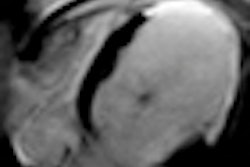
New evidence from the German cardiac CT registry has shown that CT angiography (CTA) is not followed by any further test in two out of three patients, is followed by invasive angiography in less than 20% of cases, and helps to avoid invasive angiography in 40% of patients.
These observations are independent from the performance and the result of a previous stress test, according to Dr. Alexander Leber, from the department of cardiology at the University of Munich, who presented information about the registry at the recent European Society of Cardiology (ESC) annual congress, held in Paris.
"To date, it is unknown how CTA modifies the downstream diagnostic pathway," Leber stated. He added that although CTA is highly accurate in ruling out coronary artery stenoses, an important limitation of the technique is the systematic overestimation of lesion severity, leading to false-positive findings in up to 20% of patients. This raises concerns that cardiac CT may lead to unnecessary testing under real-life conditions.
 This triple-rule-out cardiac image was captured on a Somatom Definition dual-source CT scanner without the use of beta-blockers at a heart rate of 90 bpm. Image courtesy of Siemens Healthcare.
This triple-rule-out cardiac image was captured on a Somatom Definition dual-source CT scanner without the use of beta-blockers at a heart rate of 90 bpm. Image courtesy of Siemens Healthcare.The German cardiac CT registry began on 1 July 2009, and there are 10 participating centers. By May 2011, there were 4,000 enrolled patients, 60% of whom were men. The average age was 60.2 years, and 66% were outpatients. Around 60% of the patients suffered from angina pectoris.
The plan is to expand the national database into a European cardiac CT registry, according to Dr. Jörg Hausleiter, from the German Heart Center, Technical University of Munich, who presented a poster about the German registry at ESC 2011.
The German registry monitors CTA radiation exposure and contributory factors. Data gathered so far confirm that CTA can be performed in specialized sites with low effective dose estimates, provided modern scan techniques, including axial CT data acquisition and reduced tube potential, are applied. Also, the sevenfold difference in dose between study sites reveals a potential to further reduce radiation exposure, Hausleiter noted.
Patient, procedural, and radiation-associated data are collected using a Web-based system, and an individual's score is calculated to estimate the patient's 10-year risk of fatal cardiovascular disease. The effective dose is estimated by multiplying the dose-length product with a chest conversion factor (0.014 mSv [mGy cm] -1).
The European registry is currently seeking to recruit patients by the website clinicaltrials.gov, which is a service of the U.S. National Institutes of Health. The main goal is to provide data that will help to clarify the clinical role of cardiac CT, create guidelines and recommendations for its use, and identify the most important areas that require further research. The sponsor is Stiftung Institut fuer Herzinfarktforschung. Consecutive patients undergoing CT of the heart for clinical indications are required.
The institutions taking part in the German registry are Erlangen University, DHZ TU Muenchen, Herzzentrum Muenchen-Bogenhausen, Klinikum am Eichert Goeppingen, CCB Frankfurt, Herzzentrum Ludwigshafen, Heidelberg University, Klinikum Traunstein, Kerckhoff Klinik, and Elisabeth Krankenhaus Essen. Data management tasks are performed by Herzinfarktforschung Ludwigshafen.



















